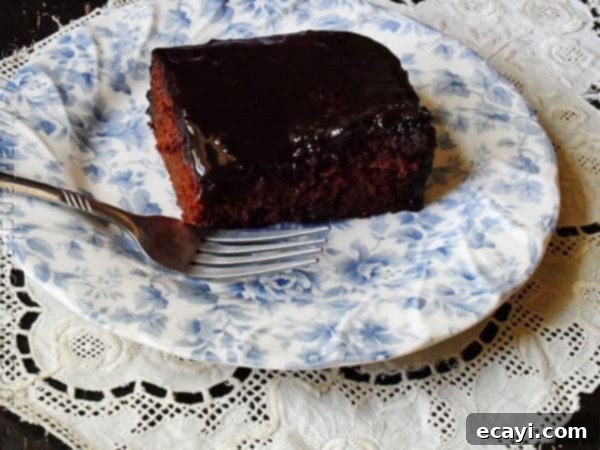The Best Moist Chocolate Prune Cake: A Decadent Dried Plum Dessert
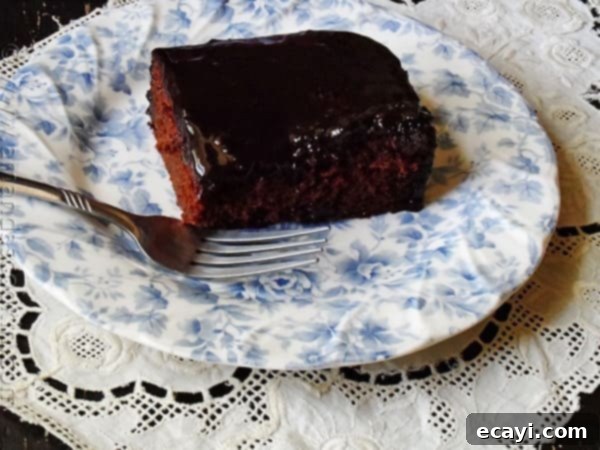
Let’s be honest, prunes don’t always get the best press. Mention “prunes” to a teenager, and you’re likely to get a look of mild disgust. They’ve earned a somewhat unfair reputation, often associated with a certain demographic. That’s precisely why I often refer to them by their more appealing name: dried plums. Because, at their core, that’s exactly what they are – wonderfully sweet, chewy, and nutritious dried plums. While we don’t call raisins “dried grapes,” prunes haven’t had the luxury of escaping the “geriatric” label, perhaps fueled by memories of a grandparent’s daily prune juice. But it’s high time we challenged that perception, especially when it comes to baking.
Prunes, or dried plums, are an incredible secret weapon in the world of baking. They bring a natural sweetness, an abundance of fiber, and a remarkable ability to add unparalleled moisture to cakes and other desserts. This isn’t just about nutrition; it’s about texture and flavor. When incorporated correctly, prunes melt seamlessly into the batter, leaving behind a subtle, rich flavor and a cake that stays incredibly moist for days. They act as a natural humectant, retaining moisture far better than many other fruits or purees, ensuring every slice is perfectly tender and flavorful.
Rediscovering Prunes: From Stigma to Superstar Ingredient
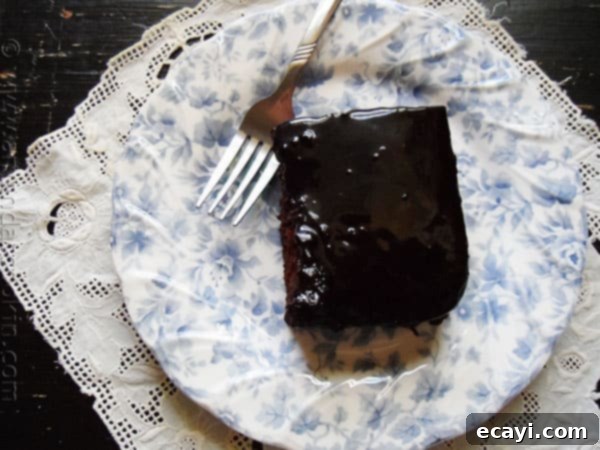
My own journey to appreciating dried plums in baking started, as many culinary adventures do, with an abundance of ingredients I needed to use up. I found myself with several bags of prunes, and the challenge was clear: how to transform these often-misunderstood fruits into something truly irresistible, something that even the most discerning palate wouldn’t recognize as “prune-y.” The goal was to create a dessert so delicious, so comforting, that the humble dried plum could “hide” within it, enhancing the overall experience without stealing the show in a way that might deter skeptical eaters. This quest led me to explore various recipes, seeking inspiration for a cake that would leverage the prune’s natural qualities while appealing to a wide audience.
The Inspiration: A Prune Cake Reimagined with Decadent Chocolate
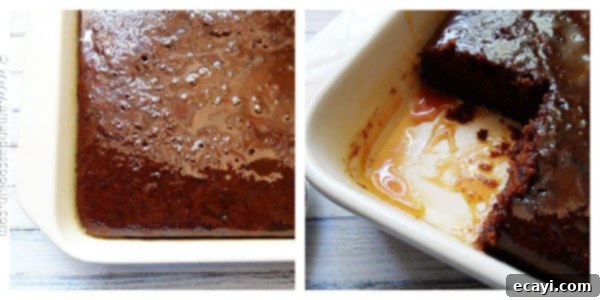 My initial breakthrough came from Ree Drummond, also known as The Pioneer Woman. Her recipe for Grandma Iny’s Prune Cake caught my eye. I followed the recipe, and the result was undeniably good. The cake was moist, flavorful, and a pleasant surprise. My family devoured it, but there was a consistent comment: they wished for less spice. While the traditional spices were lovely, they sometimes overshadowed the subtle sweetness and unique character of the prunes for some palates. This feedback sparked an idea, a culinary epiphany that would elevate the prune cake to new heights.
My initial breakthrough came from Ree Drummond, also known as The Pioneer Woman. Her recipe for Grandma Iny’s Prune Cake caught my eye. I followed the recipe, and the result was undeniably good. The cake was moist, flavorful, and a pleasant surprise. My family devoured it, but there was a consistent comment: they wished for less spice. While the traditional spices were lovely, they sometimes overshadowed the subtle sweetness and unique character of the prunes for some palates. This feedback sparked an idea, a culinary epiphany that would elevate the prune cake to new heights.
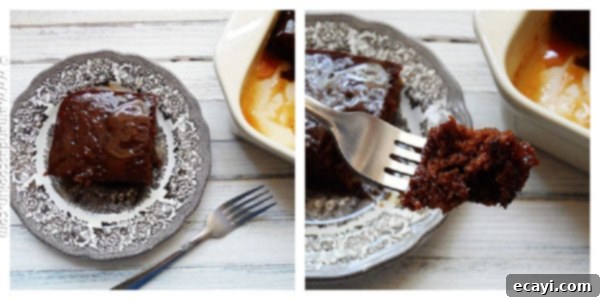 And that idea, my friends, was chocolate. Deep, rich, decadent chocolate. I envisioned a cake where the prune puree would blend seamlessly with cocoa, creating a moist, dark crumb. The earthy sweetness of the prunes, combined with the slight bitterness of cocoa, promised a sophisticated flavor profile. But why stop there? The caramel glaze from the original recipe was fantastic, offering a sweet, sticky topping. What if I infused that glaze with chocolate too? The combination promised to be a game-changer, transforming a good cake into an extraordinary one.
And that idea, my friends, was chocolate. Deep, rich, decadent chocolate. I envisioned a cake where the prune puree would blend seamlessly with cocoa, creating a moist, dark crumb. The earthy sweetness of the prunes, combined with the slight bitterness of cocoa, promised a sophisticated flavor profile. But why stop there? The caramel glaze from the original recipe was fantastic, offering a sweet, sticky topping. What if I infused that glaze with chocolate too? The combination promised to be a game-changer, transforming a good cake into an extraordinary one.
While the classic prune cake was quite good in its own right, the chocolate-enhanced version I developed was simply outstanding. The addition of cocoa powder to the cake batter and bittersweet chocolate to the caramel icing created a harmony of flavors that was irresistible. It instantly became the cake I turn to whenever I have an abundance of prunes, transforming them into a dessert that’s universally loved and requested. This recipe proves that prunes are not just for the older crowd; they are a fantastic ingredient for creating truly moist and flavorful baked goods that appeal to everyone.
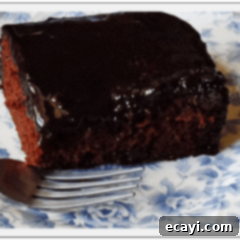
Chocolate Prune Cake
IMPORTANT – There are often Frequently Asked Questions within the blog post that you may find helpful. Simply scroll back up to read them!
Print It
Pin It
Rate It
Save ItSaved!
Ingredients
- 1 cup dried plums prunes
- 1 tablespoon vanilla extract
- 1 cup granulated sugar
- 3 large eggs
- 1 cup canola oil or other neutral oil
- 1 ½ cups all-purpose flour
- ¼ cup unsweetened cocoa powder
- 1 teaspoon baking soda
- ½ teaspoon ground cinnamon
- 1 cup buttermilk
Chocolate Caramel Icing
- 1 cup granulated sugar
- 2 ounces bittersweet chocolate chopped
- ½ cup buttermilk
- ½ teaspoon baking soda
- 1 tablespoon light corn syrup
- ¼ cup unsalted butter
- ½ teaspoon vanilla extract
Before You Begin
Instructions
-
Preheat oven to 300 F (150 C). Grease or spray a 13×9 inch baking pan thoroughly to prevent sticking.
-
Place prunes in a medium saucepan and cover with enough water to fully submerge them. Bring to a boil and cook for 7-8 minutes until the prunes are very soft and plump. Remove from heat, drain, reserving 2 tablespoons of the boiling water. Transfer the cooked prunes, vanilla extract, and reserved water into a mini food processor or blender. Puree until completely smooth, ensuring no large chunks remain. Set aside the prune puree.
-
In a large mixing bowl, combine the granulated sugar, large eggs, and canola oil. Beat well with an electric mixer on medium-high speed for 2-3 minutes until thoroughly combined and slightly lightened in color and texture.
-
In a separate medium bowl, whisk together the all-purpose flour, unsweetened cocoa powder, baking soda, and ground cinnamon until no lumps remain and the ingredients are evenly distributed. This ensures consistent flavor and rise in the cake.
-
To the large bowl containing the egg and oil mixture, gradually add the dry flour mixture, alternating with the buttermilk and the prepared prune puree. Begin and end with the dry ingredients. Stir with a spatula or mix on low speed until just combined. Be careful not to overmix the batter, as this can develop the gluten too much and lead to a tough, dense cake. A few small lumps are perfectly fine.
-
Pour the cake batter evenly into the prepared 13×9 inch baking pan. Smooth the top with a spatula. Bake for 35-40 minutes, or until a wooden skewer or toothpick inserted into the center of the cake comes out clean with no wet batter attached.
-
About five minutes before the cake is expected to finish baking, begin preparing the chocolate caramel icing. In a medium saucepan, combine all the icing ingredients: granulated sugar, chopped bittersweet chocolate, buttermilk, baking soda, light corn syrup, and unsalted butter. Place the saucepan over medium heat. Bring the mixture to a gentle boil, stirring occasionally to melt the chocolate and butter completely. Once the icing begins to boil, give it one or two quick stirs to ensure everything is well combined, then let it boil, undisturbed, for 6-7 minutes. Do not stir during this time, as it can interfere with the caramelization process and the icing’s final texture.
-
Once baked, remove the cake from the oven and immediately place it on a wire cooling rack. Remove the icing pan from heat. Give the hot icing one or two quick stirs, then carefully pour it evenly over the entire top of the warm cake. The warmth of the cake will help the icing spread beautifully. Allow the cake to cool on the rack for about 10 minutes, allowing the icing to set slightly, then slice and serve warm for the best experience.
Tips for a Perfectly Moist Chocolate Prune Cake
Achieving the perfect texture and flavor in this chocolate prune cake is simple with these helpful tips:
- Choose Pitted Prunes: Always opt for pitted prunes for convenience and safety. If you only have unpitted ones, make sure to remove all pits thoroughly before cooking and pureeing to avoid any unpleasant surprises.
- Don’t Skip the Puree: Pureeing the prunes is essential. It creates a smooth, uniform consistency that integrates beautifully into the cake batter, ensuring moisture without chunky bits that might deter some eaters.
- Buttermilk is Key: Buttermilk plays a crucial role in this recipe. Its acidity reacts with the baking soda, contributing to the cake’s light, tender crumb and moist texture. If you don’t have buttermilk on hand, you can easily make a substitute: add 1 tablespoon of lemon juice or white vinegar to a liquid measuring cup, then fill the rest of the cup with regular milk (dairy or non-dairy) until it reaches 1 cup. Let it sit for 5 minutes until it slightly curdles before using.
- Measure Accurately: Especially with baking, precise measurements are crucial for consistent results. For flour, use the spoon-and-level method: spoon flour into your measuring cup until it’s overflowing, then level off the top with a straight edge (like the back of a knife) without packing it down. Avoid scooping directly from the bag, as this can compact the flour and lead to using too much.
- Don’t Overmix the Batter: Overmixing the cake batter develops the gluten in the flour too much, which can result in a tough, chewy, and dry cake. Mix until the ingredients are just combined and no streaks of dry flour remain. A few small lumps are perfectly acceptable and won’t affect the final product.
- Keep an Eye on the Icing: The boiling time for the chocolate caramel icing is important for achieving the right consistency. Undercooking will result in a runny icing, while overcooking will make it too thick and potentially grainy. Stick to the 6-7 minute timeframe for a gentle boil, and remember not to stir during this critical period.
Serving Suggestions for Your Decadent Prune Cake
While this Chocolate Prune Cake is absolutely delightful on its own, it truly shines when served warm with a few well-chosen accompaniments. As mentioned in the recipe notes, my family’s favorite way to enjoy it is gently heated in the microwave for a few seconds, then topped with a generous scoop of creamy vanilla ice cream. The contrast between the warm, rich cake and the cold, melting ice cream is simply irresistible and creates a luxurious experience.
Other fantastic serving ideas to elevate your chocolate prune cake include:
- Freshly Whipped Cream: A dollop of freshly whipped cream adds a wonderful lightness and a delicate dairy note that perfectly complements the rich chocolate and prune flavors without being overly sweet.
- Simple Dusting of Cocoa or Powdered Sugar: For a more elegant or minimalist presentation, a light dusting of unsweetened cocoa powder or powdered sugar can add a beautiful finish and a subtle extra touch of flavor.
- Berry Compote or Raspberry Sauce: Introduce a delightful tartness by serving a warm berry compote (made with mixed berries or raspberries) or a drizzle of homemade raspberry sauce alongside. The fruitiness cuts through the richness of the cake beautifully.
- With Coffee or Tea: This moist and flavorful cake pairs wonderfully with a hot cup of freshly brewed coffee, a robust black tea, or even a comforting glass of cold milk for a simple yet satisfying treat.
- Orange Zest: A little fresh orange zest grated over the top before serving can add a bright, aromatic counterpoint to the deep chocolate and prune notes.
Storage and Freezing Instructions
This moist chocolate prune cake keeps remarkably well, making it a fantastic option for baking ahead for gatherings, for meal prepping desserts, or for simply enjoying over several days. Proper storage will ensure every slice is as delicious as the first.
- Room Temperature: Store any leftover cake in an airtight container at room temperature for up to 3-4 days. The natural moisture from the prunes helps the cake stay incredibly fresh and soft for an extended period.
- Refrigerator: For longer storage, you can refrigerate the cake in an airtight container for up to a week. While refrigeration can sometimes dry out cakes, the prune puree in this recipe helps it retain its moisture. For the best texture and flavor, bring the cake to room temperature or gently warm it in the microwave for a few seconds before serving.
- Freezing: This chocolate prune cake freezes beautifully, allowing you to enjoy it much later! To freeze, ensure the cake is completely cooled. You can wrap individual slices tightly in plastic wrap, then an additional layer of aluminum foil to prevent freezer burn. For a whole cake, wrap it securely in multiple layers of plastic wrap and then foil. Freeze for up to 3 months. To thaw, simply unwrap the desired portion and let it sit at room temperature for a few hours, or warm gently in the microwave until heated through.
Frequently Asked Questions about Chocolate Prune Cake
- Q: Why use prunes in a cake? Do they make the cake taste strongly of prunes?
- A: Prunes are fantastic in cakes because they add incredible moisture, natural sweetness, and a lovely depth of flavor without making the cake taste overtly like prunes. When pureed and combined with chocolate and other ingredients, their distinct flavor becomes very subtle, blending into a rich, deep taste profile. Most people won’t even guess there are prunes in it; they’ll just notice how wonderfully moist and flavorful the cake is!
- Q: Can I use fresh plums instead of dried prunes?
- A: No, this recipe specifically calls for dried plums (prunes). Fresh plums have a much higher water content and a different sugar concentration and texture, which would significantly alter the cake’s chemistry, texture, and moisture balance. Stick to dried prunes for the best and most reliable results.
- Q: What if I don’t have a food processor for the prunes?
- A: If you don’t have a mini food processor or a full-sized one, you can use a high-powered blender. Ensure the prunes are very soft after boiling. You may need to add a tiny bit more of the reserved boiling water (a teaspoon at a time) to help them blend into a smooth puree. Alternatively, you can finely chop them by hand, but aim for a very fine chop to ensure they integrate well into the batter; the texture of the cake might be slightly less uniform if not pureed.
- Q: Can I reduce the sugar in the recipe?
- A: While prunes do contribute natural sweetness, the sugar in this recipe (both in the cake and the icing) is carefully balanced for flavor and also contributes to the cake’s structure and moisture. Significant sugar reduction could affect the cake’s texture, tenderness, and overall balance. For best results, especially if it’s your first time making it, we recommend following the recipe as written.
- Q: Is this chocolate prune cake healthy?
- A: While this is a delicious and decadent dessert, it is still a cake with sugar and oil, so it should be enjoyed in moderation as part of a balanced diet. However, the inclusion of prunes does add beneficial dietary fiber and antioxidants, offering a little extra nutritional boost compared to some other cake recipes.
- Q: Can I use different types of chocolate for the icing?
- A: Bittersweet chocolate is specifically recommended for the icing because it provides a deep, rich chocolate flavor that perfectly balances the sweetness of the caramel and prune notes. You could experiment with semi-sweet chocolate for a slightly sweeter icing, but milk chocolate might make the icing overly sweet and less complex in flavor. White chocolate is not recommended as it has a very different flavor profile and fat content.
- Q: How can I tell if my cake is done baking?
- A: The best way to check for doneness is to insert a wooden skewer or toothpick into the very center of the cake. If it comes out clean with no wet batter attached, your cake is ready. If it still has wet crumbs, bake for a few more minutes and re-test.
The recipes on this blog are tested with a conventional gas oven and gas stovetop. It’s important to note that some ovens, especially as they age, can cook and bake inconsistently. Using an inexpensive oven thermometer can assure you that your oven is truly heating to the proper temperature. If you use a toaster oven or countertop oven, please keep in mind that they may not distribute heat the same as a conventional full sized oven and you may need to adjust your cooking/baking times. In the case of recipes made with a pressure cooker, air fryer, slow cooker, or other appliance, a link to the appliances we use is listed within each respective recipe. For baking recipes where measurements are given by weight, please note that results may not be the same if cups are used instead, and we can’t guarantee success with that method.
